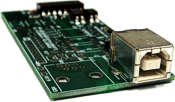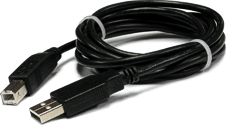USB Interface Board for Micron MM50 Series Electronics 1/8 DIN Instruments

Key Features
- Suitable for all 1/8 DIN Micron DPMs, counters, timers & remote displays.
- USB Type-B connector for plug-and-play connection to a PC USB port.
- Allows multiple meters to be connected to a PC via a hub.
- Data rates selectable up to 19,200 baud.
- Powered by instrument.
- Isolated from meter and power grounds.
 |
 |
 |
 |
Description
 The Micron USB serial communication board allows a Micron 1/8 DIN digital panel meter, counter or timer to be interfaced to a PC with an available USB port. Its primary use is as an alternative to the Micron RS232 board for programming, since most new computers now feature multiple USB ports as opposed to RS232 ports. As for the RS232 board, connection to a PC allows programming via Micron's free Windows-based Instrument Setup Software, or to output readings to a PC for display and datalogging. Connecting the USB board to a PC will cause the PC to download the required driver.
The Micron USB serial communication board allows a Micron 1/8 DIN digital panel meter, counter or timer to be interfaced to a PC with an available USB port. Its primary use is as an alternative to the Micron RS232 board for programming, since most new computers now feature multiple USB ports as opposed to RS232 ports. As for the RS232 board, connection to a PC allows programming via Micron's free Windows-based Instrument Setup Software, or to output readings to a PC for display and datalogging. Connecting the USB board to a PC will cause the PC to download the required driver.
A single USB meter is normally connected to a host computer via an off-the-shelf USB line with A and B connectors. The line can be up to 5.0 m (16.4 ft) long according to the USB standard. Micron's driver will assign a COM port address to the connected device, which is then treated like an RS232 device.

Multiple USB meters can also be connected to the host computer by using powered hubs, which can branch the original USB line from the computer into multiple lines. Theoretical limits are up to four hubs in series for five tiers of lines, a maximum line length of 5 m per tier (up to 25 m total), and up to 127 devices including the hubs. Micron's driver will assign a unique COM port address (out of an available 256 addresses) to each connected device, which is then addressed as a single device on a port.
Multiple meters can also be digitally addressed using alternative interface boards: Ethernet board, Ethernet-to-RS485 converter board, USB-to-RS485 converter board, RS485 board with dual RJ11 connectors, and RS485 board with dual RJ45 connectors. A USB board is recommended if the objective is to interface a single meter to a PC with an available USB port.
Three serial protocols are user-selectable: Modbus RTU, Modbus ASCII, and Micron ASCII. The Micron ASCII protocol is the simplest and is recommended if Microns are the only devices on the network. For more information, please see our Modbus Protocol Serial Communications Manual and our Serial Communications Manual.
Installation
 The Micron USB 2.0 board provides a USB Type-B connector for plug-and-play connection to the USB port of a PC. It is ideal for use with a PC to program a Micron meter using Instrument Setup Software. The required USB cable is readily available in computer stores and also from Micron as P/N CBL05.
The Micron USB 2.0 board provides a USB Type-B connector for plug-and-play connection to the USB port of a PC. It is ideal for use with a PC to program a Micron meter using Instrument Setup Software. The required USB cable is readily available in computer stores and also from Micron as P/N CBL05.
 |
 |
| USB Type-B connector | USB cable, P/N CBL05 |
Micron Software Requiring a Communications Board
- Instrument Setup Software runs on a PC and provides a Windows Graphical User Interface (GUI) as an alternative to programming the meter from the front panel. This software can be downloaded from this website at no charge. Its use requires a serial communications board in the meter, but following setup that board can be removed if desired. Compatible with Modbus or Micron ASCII protocol.
- Custom Curve Linearizing Software is compatible with the Extended option version of all Microns. Not applicable to temperature. Custom curve linearization can provide exceptional accuracy from low cost transducers and extend their working range on the high and low ends. This software can be downloaded from this website at no charge. Meter setup requires a serial communications board in the meter and the Micron ASCII protocol, but following setup that board can be removed if desired and any protocol can be used.
- Data Logging Software turns a PC into a data logging system. The RS232 board allows data logging with a single meter. Use of RS485 boards allows data logging with up to 31 Micron instruments. Data can be logged from selected meters into an ASCII file, which can then be imported into MS Excel. Data can also be displayed on the computer screen in the form of up to 64 actual or virtual panel meters in 4 groups (or screens) of up to 16 meters each. Compatible with Micron ASCII protocol only.
Specifications
Electrical Specifications
| Ethernet Board Specifications | |
|---|---|
| Data rates | 300, 600, 1200, 2400, 4800, 9600, 19200 bps |
| Devices per Ethernet line | 1 per line |
| Connector | USB Type-B receptable |
| Line length, max | 5 m |
| Standards compliance | Universal Serial Bus Spec Revision 2.0, Full Speed |
| Isolation | 250V rms working, 2.3 kV rms per 1 min test |
| ESD Protection | 15 kV per IEC 1000-4-2 |
| EMI Immunity | 10 V/m per IEC 1000-4-3 |
| EFT Protection | 2 kV per IEC 1000-4-4s |
| Short Circuit Protection | Continuous |
| Selectable Protocols | Modbus RTU, Modbus ASCII, Micron ASCII. |
Protocol Specifications |
(implemented on meter main board) |
| Modbus RTU | |
|---|---|
| Standards Compliance | Modbus over Serial Line Specification V1.0 (2002) |
| Data Formats (selectable) | 1. No parity, 8 data bits, 2 stop bits |
| 2. Odd parity, 8 data bits, 1 stop bit | |
| 3. Even parity, 8 data bits, 1 stop bit | |
| Applicable Interface Boards | Ethernet, USB, RS232, RS485, RS485 Modbus |
| Conversion to Modbus TCP | Automatic |
| Main Board Revision Level | Level 5 or above |
| Modbus ASCII | |
| Standards Compliance | Modbus over Serial Line Specification V1.0 (2002) |
| Data Formats (selectable) | 1. No parity, 7 data bits, 2 stop bits |
| 2. Odd parity, 7 data bits, 1 stop bit | |
| 3. Even parity, 7 data bits, 1 stop bit | |
| Applicable Interface Boards | Ethernet, USB, RS232, RS485, Modbus RS485 |
| Conversion to Modbus TCP | Automatic |
| Main Board Revision Level | Level 5 or above |
| Micron ASCII | |
| Data Format | No parity, 8 data bits, 1 stop bit |
| Protocol | Micron Micron ASCII |
| Applicable Interface Boards | Ethernet, USB, RS232, RS485, RS485 Modbus |
| Main Board Revision Level | Any |
